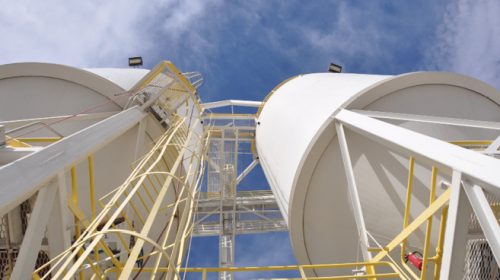Salt River Materials terminal leverages Class C feed to raise Class F ash output
Scottsdale, Ariz.-based Salt River Materials Group (SRMG) has added advanced blending capability to increase its stock of Class F fly ash, supplies of which have tightened due to weather and regulatory factors, plus changes in electric power generation.
|
|
| Class C (left) and Class F silos. |
The producer landed an ash management contract in May 2016 for the Coronado Generating Station in St. John’s, Ariz., where twin, 400-megawatt units run on low sulfur, Powder River Basin coal, and net up to 150,000 tons of Class C ash annually. Coronado joins contracts SRMG has acquired since 1973 covering Class F fly ash management at four Arizona and New Mexico generating stations; a contract involving a fifth such source, the Deseret Power Electric Cooperative station in Bonanza, Utah, just took effect (note page 34).
Although widely adopted in manufactured concrete and stucco, Class C fly ash is restricted in key Southwest markets due to agency concerns with the material’s limited role in combating alkali-silica reactivity (ASR). To extend supply of Class F ash, synonymous with ASR factors and concrete mix economy, SRMG has engineered a system at its 19th Avenue Terminal, one of the company’s five cementitious materials distribution facilities serving the Phoenix market.
 |
| The 19th Avenue Terminal is located along a BNSF rail line just south of downtown Phoenix. SRMG serves ready mixed and precast concrete producers across the market from five fly ash and portland cement terminals. |
 |
| The Cyclonaire CB-150 Blend-Veyors operate at the base of Class C and Class F silos. |

|
| With 16 symmetrically placed aeration points, they equip the 19th Avenue Terminal to process Class F-grade ash bearing Class C ash content, or customize Class C-F blends. |
Twin Cyclonaire CB-150 Series Blend-Veyors have been deployed to blend and convey Class C and Class F ashes in semi-dense phase. Through precise weighing and robust blending, the CB-150s finish powder with calcium oxide content and other properties equivalent to a Class F ash per ASTM C618, Standard Specification for Coal Fly Ash and Raw or Calcined Natural Pozzolan for Use in Concrete.
The 19th Avenue Terminal has four conventional elevated silos, two 200-ton and two 400-ton capacity, plus a main, 5,000-ton slip formed concrete structure at grade. The Blend-Veyors rest at the base of the larger elevated silos, Class C forward, Class F aft. A series of air slides crisscrossing lower and mezzanine levels, and linking the four elevated vessels, will maximize the variety of Class C-F blends deliverable on short leads.
The CB-150 Blend-Veyors consist of pods holding up to 4,500 lbs. of material and bearing on load cells, plus lower cone portions with 16 aeration points. A typical 90-second blending cycles equates to 25-30 tons/hour output. “We have blended Class C and Class F ashes by a more conventional, but less precise method: Blowing material simultaneously from two railcars into a dedicated silo,” says SRMG Senior Vice President, Pozzolans Dale Diulus, P.E. “The new equipment supports a reproducible process, with much more verifiable blends of Class C and Class F ash feeds.”
RAIL LOADS
Salt River Materials has conducted extensive testing on ASR potential and sulfate resistance of concrete specimens prepared with the blended Class F-grade ash; agency-geared technical support activities and demonstrations to prove the material’s performance continue. Approval of Class C-F ash blends by Arizona and Southwest agencies would mirror action by Alabama, Florida and Nebraska Departments of Transportation.
 |
| Main 19th Avenue Terminal silo. |
The Blend-Veyor installations are part of an upgrade enabling SRMG to increase 19th Avenue Terminal capacity. Additional work includes construction of a small concrete masonry enclosure to house twin 150-hp blowers (one for each CB-150 unit) running 1,680 cubic feet/minute at 14 psi; and, a near-doubling of track area for the existing 36-car rail yard, served by a BNSF line.
SRMG uses pressure differential or pneumatic rail cars versus bottom dump models. Pneumatic unloading is better suited to Class F fly ash, which is more fluid-like than Class C ash or portland cement. New 19th Avenue Terminal rail area will handle either pneumatic or bottom dump cars. The facility is among 22 SRMG distribution or material processing points: seven Arizona, six California, five New Mexico, plus individual Colorado, Nevada, Texas and Utah sites. Fly ash marketing goes hand in hand with portland cement sales from the charter business, Phoenix Cement in Clarkdale, Ariz., and aggregates from Salt River Sand & Rock in Phoenix.
BONANZA CONTRACT
 |
| PHOTO: Gina Strole Photography |
